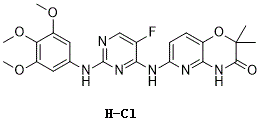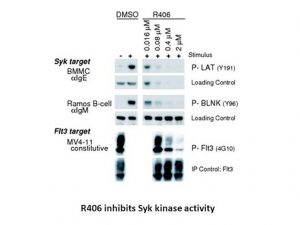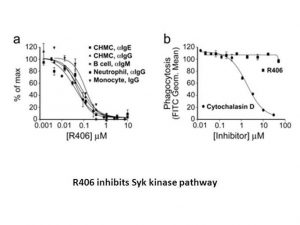This product is for research use only, not for human use. We do not sell to patients.

| Size | Price | Stock |
|---|---|---|
| 5mg | $98 | 3-6 Days |
| 10mg | $150 | 3-6 Days |
| 25mg | $246 | 3-6 Days |
| 50mg | $369 | 3-6 Days |
| 100mg | $595 | 3-6 Days |
| 250mg | $1180 | 3-6 Days |
| 500mg | $1920 | 3-6 Days |
Cat #: V3899 CAS #: N/A Purity ≥ 99%
Description: Tamatinib HCl (formerly known as R406 HCl) is a novel potent and ATP competitive Syk inhibitor with IC50 of 41 nM in cell-free assays, it strongly inhibits Syk but not Lyn, 5-fold less potent to Flt3. R406 impairs platelet activation and monocyte tissue factor expression triggered by heparin-PF4 complex directed antibodies. R406 blocks fc receptor signaling and reduces immune complex-mediated inflammation. R406 inhibited phosphorylation of Syk substrate linker for activation of T cells in mast cells and B-cell linker protein/SLP65 in B cells. R406 bound to the ATP binding pocket of Syk and inhibited its kinase activity as an ATP-competitive inhibitor (Ki = 30 nM). R406 blocked Syk-dependent FcR-mediated activation of monocytes/macrophages and neutrophils and BCR-mediated activation of B lymphocytes.
Publications Citing InvivoChem Products
Product Promise

- Physicochemical and Storage Information
- Protocol
- Related Biological Data
- Stock Solution Preparation
- Quality Control Documentation
| CAS No. | N/A |
|---|
| Protocol | In Vitro | In vitro activity: R406 is an ATP-competitive inhibitor of Syk with a Ki value of 30 nM. R406 selectively inhibits Syk-dependent signaling with EC50 values ranging from 33 nM to 171 nM, more potently than Syk-independent pathways in different cells. R406 inhibits cellular proliferation of a large panel of diffuse large B-cell lymphoma (DLBCL) cell lines at EC50 values ranging from 0.8 μM to 8.1 μM. R406 treatment (1 μM or 4 μM) induces the activation of caspases 9 and 3, but not caspase 8, leading to significant apoptosis of the majority of DLBCL cell lines. Pretreatment of R406 completely blocks the phosphorylation of SYK525/526 and the SYK-dependent phosphorylation of BLNK in R406-sensitive DLBCLs following B-cell receptor (BCR) crosslinking. R406 potently decreases MMP-9 mRNA levels by 2.8- and 4.3-fold lower than controls after 24 and 48 hours treatment, respectively, and reduces the invasive capacity of the RL cells. Kinase Assay: R406 is serially diluted in DMSO and then diluted to 1% DMSO in kinase buffer (20 mM HEPES, pH 7.4, 5 mM MgCl2, 2 mM MnCl2, 1 mM DTT, 0.1 mg/mL acetylated BGG). ATP and substrate in kinase buffer are added at room temperature, resulting in a final DMSO concentration on 0.2%. The kinase reactions are performed in a final volume of 20 μL containing 5 μM HS1 peptide substrate and 4 μM ATP and started by addition of 0.125 ng of Syk in kinase buffer. The reaction is allowed to proceed for 40 minutes at room temperature. The reaction is stopped by the addition of 20 μL of PTK quench mix containing EDTA/anti-phosphotyrosine antibody (1X final)/fluorescent phosphopeptide tracer (0.5X final) diluted in FP Dilution Buffer. The plate is incubated for 30 minutes in the dark at room temperature and then read on a Polarion fluorescence polarization plate reader. Data are converted to amount of phosphopeptide present using a calibration curve generated by competition with the phosphopeptide competitor provided in the Tyrosine Kinase Assay Kit. For IC50 determination, R406 is tested at eleven concentrations in duplicate and curve-fitting is performed by non-linear regression analysis using Prism GraphPad Software. Cell Assay: DLBCL cell lines are treated with serial dilutions of R406 (0.3, 0.6, 1.25, 2.5, or 5 μM) for 72 or 96 hours. Thereafter, cellular proliferation is determined by MTT assay, and cell apoptosis is assessed by using annexin V–FITC/propidium iodide (PI) staining. For the determination of caspase 9, 8, and 3, cells are lysed, size-fractionated by polyacrylamide gel electrophoresis (PAGE), and immunoblotted. |
|---|---|---|
| In Vivo | R406 has shown efficacy in a number of animal models of immune disorders. Oral administration of R406 in mice with immune complex-mediated inflammation significantly inhibits the cutaneous reverse passive Arthus reaction by approximately 72% and 86% at 1 mg/kg and 5 mg/kg, respectively, compared with the control. R406 treatment at 10 mg/kg significantly reduces inflammation and swelling, decreases the progressive arthritis to a lower level in the passive anticollagen antibody-challenged mice, and delays the onset and reduces paw thickening and clinical arthritis by approximately 50% in the K/BxN serum transfer mice model. | |
| Animal model | Female C57BL/6 mice challenged intravenously with 1% ovalbumin (OVA) in saline (10 mg/kg) containing 1% Evans blue dye, female Balb/c mice with the anticollagen antibody-induced arthritis, and female C57BL/6 mice with arthritis induced by intraperitoneal |
This equation is commonly abbreviated as: C1 V1 = C2 V2
- (1) Please be sure that the solution is clear before the addition of next solvent. Dissolution methods like vortex, ultrasound or warming and heat may be used to aid dissolving.
- (2) Be sure to add the solvent(s) in order.







































